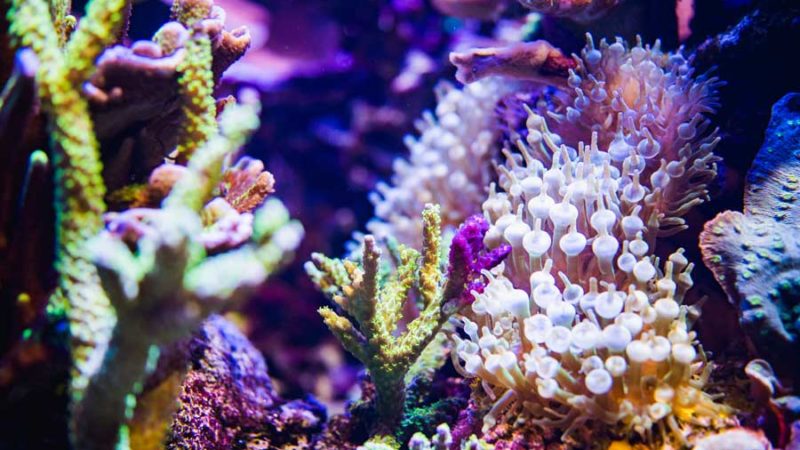Growing a Coral Reef in an Aquarium

Published August 31, 2018
By: Jackie S., Aquarist
If your aquarium tour has taken you past our lower-level Out to Sea exhibit where you saw sharks and grouper, you have probably seen our corals. The three part coral exhibit at Wonders of Wildlife is actually one life support system, meaning that the three exhibits share the same water and filtration. This setup allows an aquarist to monitor and adjust water chemistry parameters such as temperature, salinity, and the specific nutrient levels that corals require, such as Calcium and Magnesium, for the three exhibits all at once.
Some of the most important aspects of building and maintaining a coral exhibit are nutrient availability, light and water flow. Corals usually grow in shallow, very clear water with an abundance of sunlight and moderate turbulence. We recreate a natural environment by hanging full spectrum ultra-violet L.E.D lights above the three sections of the system to artificially supply sunlight, adding a powerhead or flow diverter to artificially create water movement, and by supplementing the water with macro-elements.

As Corals are extremely sensitive animals, they are very susceptible to even the smallest changes in water chemistry. An active coral system requires attentiveness to water quality on a level that far exceeds that necessary for exhibits with only fish. Daily water quality testing occurs to ensure levels of Ammonia, Phosphates, Nitrites and Nitrates remain very low to non-existent and that levels of Alkalinity, Salinity, and pH levels remain within defined ranges. Of greatest importance for the long term, however, is assessment and remediation of Calcium and Magnesium levels as these elements are crucial to coral skeleton development.
Under ideal conditions, corals in aquariums can grow at a rate that far exceeds their growth rate in the wild. That being said, the reef exhibits here at Wonders of Wildlife were set up three years ago, and what you see today is the growth that has occurred over that time. Sometimes, however, rapid coral growth can cause issues in an aquarium setting because of the size limitations of an exhibit. Left untended corals can outgrow their space, and when they do, they begin to impede other colonies around it. Coral warfare then occurs, where each colony tries to out-compete the other for space, and therefore resources, by the use of their stinging cells – nematocysts.
One way to cut back on coral warfare is to do a bit of coral “gardening†or Fragging. By carefully clipping off pieces of corals, called frags, the pieces can then be transplanted and allowed to develop into a new colony while remaining genetically identical to its parent colony. This process allows for an aquarium to be able to trade corals with other facilities around the country instead of removing more from the wild. Additionally, because the corals are grown in a captive setting and are typically genetically different from the colonies in the wild and can provide new genetic material for reproducing corals in our oceans when placed on a wild reef. Overall, this helps aid reef health and is a great tool in coral reef conservation and restoration.
Coral reefs are some of the most diverse environments in the entire world. Such an expansive habitat can offer homes, nurseries, and hunting grounds for a variety of saltwater fish and invertebrates. Reefs are their own complete ecosystem, and the reef tanks at Wonders of Wildlife showcase that fact just like their ocean counterparts. We hope you enjoy ours!
News & Updates
Read the latest news & updates about Wonders of Wildlife.
Recent News & Stories
- A Thank You to Our Volunteers!
- Creature Feature: Hellbenders
- Member Night Recap: March 11, 2024
- Celebrating Women: Their Notable Impact on Fishing & Conservation
- Wonders of Wildlife’s Sea Turtle Center again hosts endangered sea turtles in life-saving rehabilitation efforts
- It’s Official! Johnny Morris’ Wonders of Wildlife Vote “America’s Best Aquarium for an unprecedented fifth time!
- Cast Your Vote for Conservation
